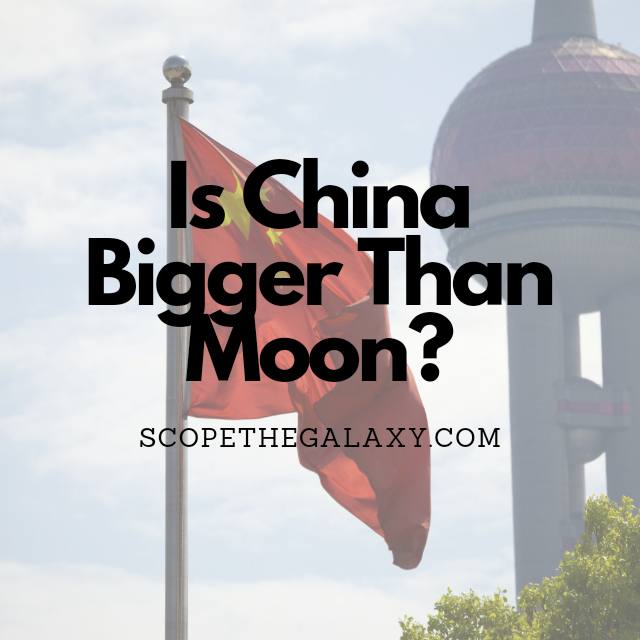*This post may contain affiliate links. This means we may make a commission if you purchase an item using one of our links*
China is the third largest country on Earth, while the Moon is the 5th largest moon in our Solar System. The Moon has a surface area of 37.9 million sq. km while China’s is far lesser at 9.7 million sq. km. In regards to volume China’s is 462 million cubic km whereas the Moon’s is 21.9 billion cubic km. As a result the Moon is much bigger than China.
Continue reading for a more detailed look at each entities size below along with a number of their unique surface features.
How Big Is China?
China – officially named the People’s Republic of China – is the third largest country in the world and is located in East Asia. It is also the most populous country in the world, with a population of over 1.4 billion people.
China has a land area of 9,388,211 sq. km and a total area of 9,706,961 sq. km. The total area comprises not only the land mass but also the bodies of water (such as lakes and rivers). China has a diameter of 5,000 km stretching from east to west and a north-south length of 5,500 km.
One-third of China’s total land area comprises mountains, and it is home to the tallest peak in the world, Everest, which occupies the border between China and Nepal. Thanks to this mountainous terrain, the average thickness of China’s continental crust is 47.6 km (the average global thickness is 39.2km). This gives China an estimated volume of 462,051,344 cubic km.
The topography of China is varied and encompasses the highest and one of the lowest places on Earth, with climates that vary from dry desert to tropical monsoon. In fact, China has the greatest north-south temperature contrast of any country in the world.
China’s coastline runs for around 14,000km, while its land frontier extends to 20,000km to encompass its borders with 14 other countries, including Russia, Mongolia, India, and Kazakhstan. Generally speaking, China has a high west side and a low east side, meaning that many of its rivers flow eastward.
The vast expanse of this country covers almost five time zones, but China operates under a single time zone to unify the country.
How Big Is The Moon?
We see the moon shining each evening; still, it is difficult to quantify precisely how large this celestial body is when we are so far away from it. The moon appears round, but like the Earth, it is not a perfect sphere. Instead, it is an oblate spheroid (or a slightly squashed ball).
Due to its shape, the diameter at the equator is larger than the measure from pole to pole. However, the difference – a tiny 4 kilometers – is pretty insignificant when we look at the overall size of the moon. The Moon’s equatorial diameter is 3,476km, or if we measure pole to pole, it is 3,472km.
Either way, the moon’s diameter is over 1,000km more than the continent of Asia from east to west or from north to south but, when the measurement is done from the Arctic Circle to the Indian Ocean, Asia’s diameter is a little over 3 times that of the Moon
When we look at the surface area, we see the moon is actually far lower; the surface area of Asia is approximately 44,579,000 sq km, while the moon’s surface area is around 37,940,000 sq km, making it almost 7 million less.
however, if you simply look at this natural satellites volume, it completely outclasses Asia’s number, where it is 21.9 billon cubic kilometers, more than 5 times Asia’s numbers of 2.78 billioncubic kilometers
If you look at the moon, you’ll see a mixture of dark areas, representing the extensive flat lunar plains, and bright regions full of mountainous highlands. During early observations, scientists thought that the dark areas were full of water, but today we know that no liquid water is available on its airless surface.
On Earth, mountains form by volcanic or tectonic action. In contrast, the mountainous ranges on the moon formed almost exclusively from crater impacts. Here, mountains are labeled using their Latin names; montes (mountain ranges) and mons (individual mountains).
The two most significant mountain ranges are the northern Montes Caucasus and the southern Montes Apenninus; they separate the Sea of Serenity from the Sea of Showers. In the northwest, the Montes Alpes – or the lunar Alps – encase the Plato crater.
Among the most impressive single peaks on the moon are Mons Piton and Mons Pico. Mons Piton has a base diameter of 25 km and stretches 2,250m into the area. Mons Pico has a 15 km by 25 km base and a height of 2,400m. While these mountains are impressive, they are dwarfed by some of Earth’s mountain peaks, like Everest.
Summary
China may be the 3rd largest country on Earth but the Moon still absolutely dwarfs it in both surface are and volume.
After all the spherical shape of the Moon does mean it will be signfiantly bigger than the flat land mass that China is, where the Moon is roughly 4 times bigger in surface area and around 50 times larger in volume.

